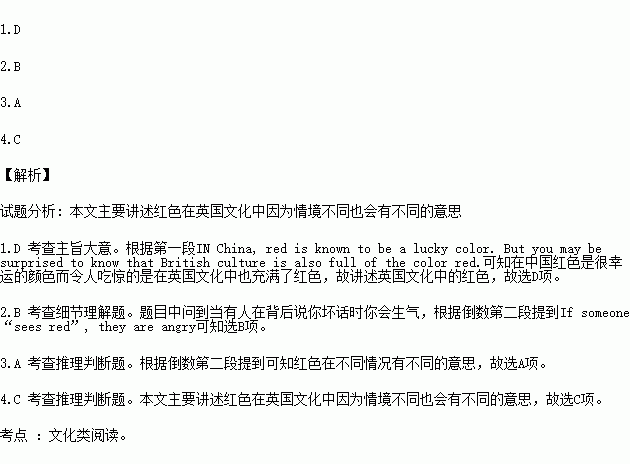题目内容
IN China, red is known to be a lucky color. But you may be surprised to know that British culture is also full of the color red. It’s true: Go to Britain and you will see red everywhere.
There are red postboxes on street corners and on the sides of buildings. The British red phone box is famous all over the world. The famous double-decker (双层) bus is red. Red is the color traditionally worn by British soldiers in battle (战争), and there is red in the UK’s Union Jack national flag. Britain even has a famous team of stunt (特技) jet fighters (喷气式战斗机) called “The Red Arrows”.
To go with British culture’s love of red, British nature also features many red animals. A beloved bird is the robin (知更鸟), which has a bright red breast (胸脯). At Christmastime in winter, the bird is commonly found on the greetings cards people send each other. There is also quite a rare animal called the red squirrel (松鼠). Foxes are red, and they used to be hunted by men in red outfits (服装).
But is red considered lucky to British people? A good way to see how a culture looks at a color is to look at the way it uses it in language. The results may surprise you. Even though Britain has a lot of red on its high streets and in its countryside, red is used quite differently as a metaphor (比喻). If someone “sees red”, they are angry. When a person is “red faced”, they are out of breath or blushing (脸红). Red is also a political color: it means a left-winger (blue is the color of the political right). To be “in the red” is to be in debt (someone in credit (存款) is “in the black”).
Look hard enough and you’ll find the color red being used in all countries. For instance the “red heart” symbol (符号) is pretty universal. But whether the British realize it or not, red is everywhere in Britain. It does seem that the country is in love with the color.
1. The article is mainly about ______.
A. the metaphor of red in the English language
B. the preference for red animals in Britain
C. the history of red items in Britain
D. the color red in British culture
2. Someone saying bad words about you behind your back might make you ______.
A. red-faced B. see red
C. in the red D. in the black
3. It can be inferred from the article that ______.
A. red has different meanings depending on the context (情境)
B. the color red is not as popular as it was before in Britain
C. most British people are aware of (知道的) how popular the color red is in British culture
D. British people are often asked to explain the meaning of the color red
4.The main purpose of the article is to ______.
A. compare B. judge C. inform D. argue
 天天向上一本好卷系列答案
天天向上一本好卷系列答案 小学生10分钟应用题系列答案
小学生10分钟应用题系列答案
